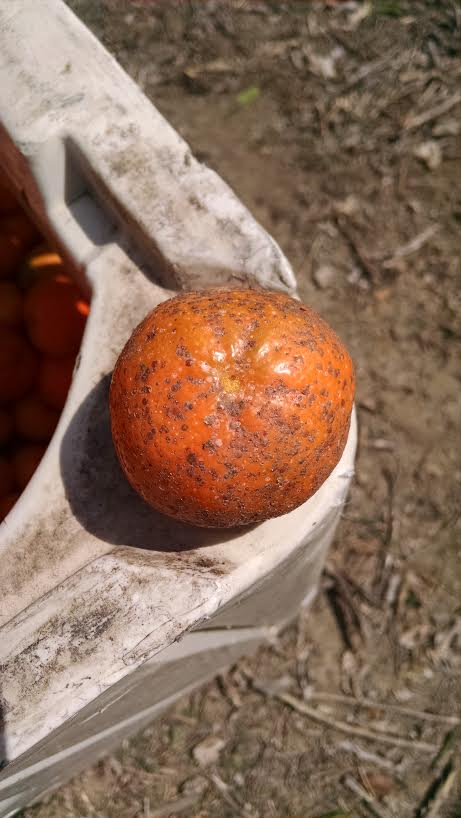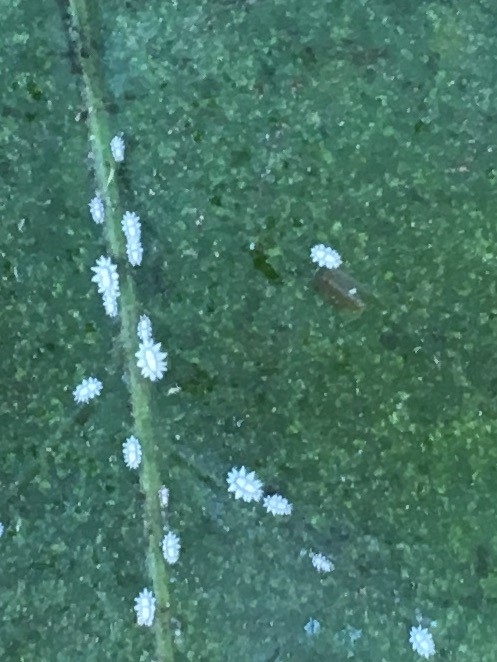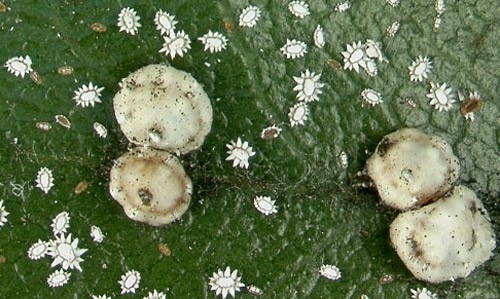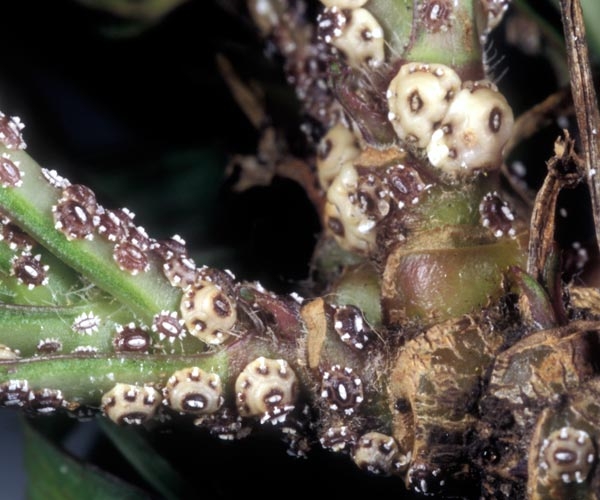- Author: Ben Faber
Recently a grower called up with a beautiful scale that the PCA couldn't identify. I could just marvel at the beauty of it and wondered what in the heck it was. It didn't look like any scale I had seen in the area and others who were queried didn't know either.
I took it into the Ag Commissioner's office and they sent it off to see if it was a new species. Images were sent off to various entomologists and David Haviland in Bakersfield identified it as a Ceroplastes, possibly a Chinese wax scale or Barnacle scale. Others had identified it as Florida wax scale.
It was sent into Paul Rugman-Jones at UC Riverside Entomology for DNA identification. His identification and that of CA Dept of Food and Ag entolomogists came back as Barnacle scale, Ceroplastes cirripediformis.
All of these scales turned out to have been seen in California before, so there was no quarantine issue. It also turned out that all of the adults that were turned in for identification had also been parasitized by some wasp. So there is biological control already in place for it. The issue at stake here, though, is that it's important to be watching for new visitors in the orchard. Joe Morse now retired from UC Riverside Entomology lead a team that intercepted avocados coming into the US. They found a number of scale insects that were new to California and new to the identification world. A number of these scale are parthenogenic, meaning they can reproduce without males, and just one lone female could possible balloon into a massive population in a short time. And on a scale like that, trees would have a hard time without some serious intervention.
- Author: Ben Faber
Argentine Ant is a very aggressive invader that disrupts native ant populations and at the same time disrupts biocontrol agents that help control, such pests as scale, aphids and mealy bugs in citrus and other tree crop species. They defend these sugar producing sources of energy from attack by predators and parasites, like parasitic wasps and predatory assassin bugs and lady bugs. They increase the threat of Asian Citrus Psyllid and HLB by protecting the psyllid from attack by parasitic Tamarixia.
A careful, well placed chlorpyrifos spray has been used to control Argentine ants. A trunk spray and/or spray on irrigation lines has disrupted their activity with minimal impact on beneficials. This protectant spray keeps the Argentine ants out of the canopies and allows the beneficials access to the pests. Controlling this one species, can have significant impact on biocontrol and the whole need for controlling pests.
Chlorpyrifos is a pesticide that might lose registration and other materials and techniques have been examined over the years as a replacement. A recent procedure has been proposed and used successfully on Santa Cruz Island to control introduced Argentine ants. The ant has caused tremendous disruption in biocontrol and it appears to have been controlled by this new technique. We are in the process of evaluating it's use in citrus. The application technique, costs and materials would need to be modified for use in citrus orchards. The current procedure would not be considered an organic practice since the pesticide material is not registered organic. It might be possible to use an organically registered material in the future.
Protocols for Argentine ant eradication in conservation areas
L.Boser1,C.Hanna2,D.A.Holway3,K.R.Faulkner4,I.Naughton3,K.Merrill5,J.M.Randall1,C.Cory1,D.-H. Choe6 & S. A.Morrison
Journal of Applied Entomology
http://onlinelibrary.wiley.com/doi/10.1111/jen.12372/full
The Argentine ant (Linepithema humile) is a widespread, abundant and ecologically disruptive invader that is present throughout major portions of coastal California and on half of the California Channel Islands. On Santa Cruz Island, the Argentine ant had invaded about 2% of the island's area in four distinct locations as of 2012. Given the negative ecological effects resulting from Argentine ant invasions,we sought to develop a cost-effective method of eradication. Here, we describe the results of large-scale, field-tested methods for Argentine ant eradication and post-treatment detection. Our eradication protocol employs a novel toxicant-delivery system: an aqueous solution of sucrose and 6 ppm of thiamethoxam mixed with hydrating polyacrylamide beads. Ants feed on the solution present on the bead's surface for about 24h after which time bead dehydration prevents feeding. We distributed hydrated beads by helicopter over 74 ha of infested areas plus a 50-m buffer on 14 occasions between June 2013 and September 2014. Treatments reduced Argentine ant activity to subdetectable levels within four months. In 2014, we conducted a high-intensity detection protocol using lures (n = 55 363) in areas treated in 2013.This effort did not detect Argentine ants. In 2015, we conducted a medium-intensity detection protocol using lures (n=2250) in areas treated in 2013 and 2014 but not searched in 2014; this sampling effort did not detect Argentine ant activity except for a single remnant infestation (c.0.3ha in area),which was retreated in2015.Thec ost of treatments was approximately $1400 per ha; this cost is comparable to other ant eradication efforts. The cost of our preferred detection method, which used lures spaced every 10m,was $500 per ha.These results demonstrate sufficient protocol efficacy to justify expansion of treatments to other infested areas in ecologically sensitive areas.
Photo: Argentine ant and scale
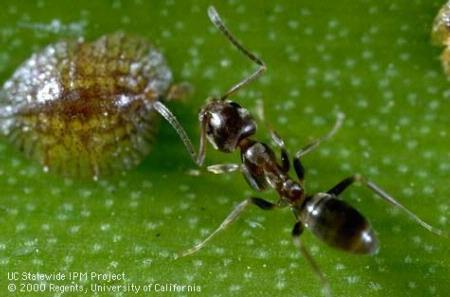
- Author: Ben Faber
The latest edition of Topics in Subtropics newsletter is out, Elizabeth Fichtner as editor. Read on.
TOPICS IN THIS ISSUE:
-
Why has California red scale been so difficult to control?
-
Navel Orange Nitrogen Fertilization
-
Recent Advances in Understanding the History of Olive Domestication
- Upcoming UC Olive Center Events

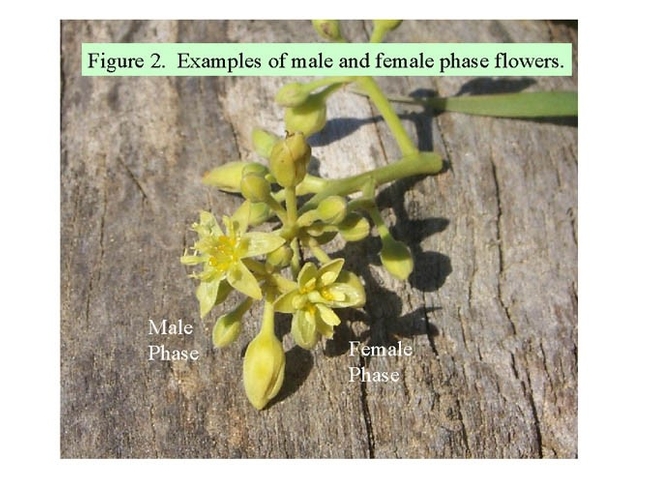
- Author: Ben Faber
It's that time of year for a riot of aphids on new growth cheeseweed (malva) and wild radish and with that food source to see ladybird beetles go to town, chowing down. There's ladybugs in both their larval and adult stages doing the feeding. Some of the larvae look like mealybugs which is a food source that they mimic and also feed on. The mealybug destroyers was introduced from Australia at the turn of the 20th century to fight citrus mealybug and when there is no disruption, they are effective at keeping the population down. Another mealybug mimic is the dusky ladybird which also feeds on scales, aphids and mealy bugs. These are generalist predators, even cannibalizing their own, when other food sources are not present. The dusky has not been common in the Ventura area, but recently, PCA Jane Delahoyde spotted one. As our weather changes, we are bound to see other insects and invertebrates move into the area.
Check out this University of Florida ladybug website:
http://entnemdept.ufl.edu/creatures/beneficial/lady_beetles.htm
Mealybug-like larval stage surrounded by aphid food (above) and adult (below)
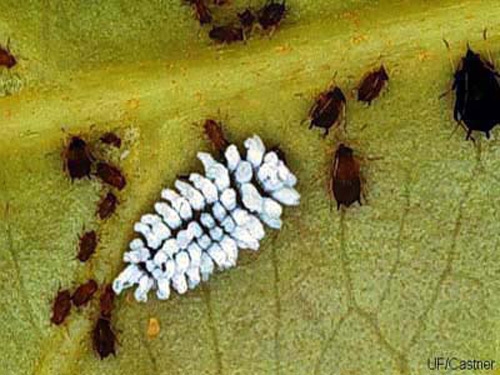
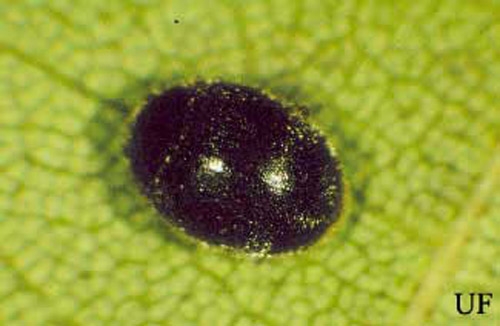
- Author: Ben Faber
It never got very cold this winter in spite of the freeze we had at the turn of the new year. Insects that are normally knocked back by cold weather such as scales and the formidable Asian Citrus Psyllid continued on very well, thank you. Along the coast we have have had a major issue with red scale in lemons, which normally is in pretty good biological control.
California red scale and yellow scale are armored scales that are distributed throughout the citrus-growing regions of the state except in parts of the Coachella Valley where they are under an eradication program. The two species are difficult to distinguish by appearance. Yellow scale, however, is rarely found on mature wood of the tree whereas California red scale can be found on the wood as well as on fruit and leaves. Biologies and management tactics for California red scale and yellow scale are similar, but yellow scale is more easily controlled by natural enemies and, thus, less commonly found.
Female scales have a roundish cover, about the size of the blunt end of a nail. The cover is firmly attached to the leaf, wood, or fruit substrate when the scales are molting or reproducing; they remain under this cover throughout their life. When mature, they produce 100 to 150 crawlers.
Crawlers hatch and emerge from under the female cover at a rate of two to three per day. Crawlers move around to find a suitable place to settle and can be spread about by wind, birds, or picking crews. They settle in small depressions on twigs, fruits, or leaves and start feeding; soon after, a circular, waxy cover forms over their body. Midway through the second instar, females and males begin to develop differently. Males form an elongated cover while the female cover remains circular. The female molts twice, developing a concentric ring in the center of the waxy covering each time.
Adult male scales are small, two-winged insects that emerge from the elongated scale covers after four molts. They live about 6 hours and their sole purpose is to mate. The number of male flights, along with the number of generations per year for this insect varies according to the growing region in the state and the weather but is generally about 4 flights per year.
Oils can be effective against California red scale if coverage is thorough. They also have the advantage of being relatively less damaging to natural enemy populations than other insecticides. However, special care must be taken to avoid applying dilute applications of oil at times when it can damage fruit and leaves or reduce populations of natural enemies. In some cases, though, growers have had to resort to more harsh chemicals such as chlorpyrifos.
